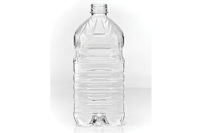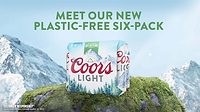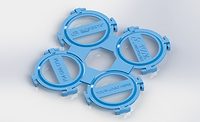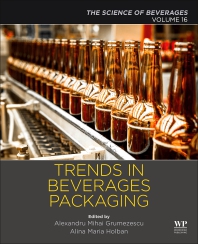Versatility can be a key component in many forms of business. For beverage manufacturers, developing products that are not only refreshing but also functional is not an uncommon practice; however, versatility doesn’t end with the finished product; it also can extend to its packaging — even its secondary packaging.
Noting that the company works primarily with large consumer packaged goods (CPG) companies, Mark Pfeiffer, vice president of sales and marketing for the performance films division of Exopack, Chicago, says that beverage-makers are looking for three things in their plastic secondary packaging: graphic excellence, functionality and sustainability.
The use of high-definition graphics as well as flat-top plating has emerged within the last two years in order to assist the creation of crisp images on shrink film, Pfeiffer adds.
“We also get consistency now where the 500,000th impression on a production run looks as good as the first impression on a production run,” he says.
Pfeiffer notes that ink technology on shrink film has seen strong improvements. “We’re working with some enhanced metallic inks, [and] this allows us to have printed shrink film that matches the look of the bottle labels that incorporate metallic inks,” he says. “We’re also working with thermochromatic inks.” Thermochromatic inks are inks that change color at a certain temperature, creating an altered image effect, he explains.
Because of the versatility of shrink film secondary packaging, working with these advanced inks can provide beverage manufacturers with more opportunities to market their products, Pfeiffer explains.
“It gives the ability for our customers to have some very special graphics for promotions and have some eye-catching features to grab the consumer’s attention,” he says. “One of the other things that we’ve been doing is inkjet coding. We can do contests where on the inside of the shrink film we can do gaming promotions; we do inkjet coding for loyalty programs for our customers, so shrink film is a very versatile substrate to work with.”
Sustainable growth
Although eye-catching graphics can be an important asset when marketing a product, some packaging material suppliers note that sustainable improvements within the plastic secondary packaging market have been the biggest winner when it comes to marketing.
Manufacturing a variety of bottle handles, bottle multipacks and beverage carriers, Charlotte, N.C.-based Roberts PolyPro, a Pro Mach company, has made sustainability a core part of its culture, according to its website.
“Not only did we minimize or try to eliminate over-packaging, we are 100 percent recyclable and then we’re also a zero-waste manufacturer, meaning we utilize 100 percent of the product in our manufacturing process — there is no waste,” says Chris Turner, sales director for plastic for Roberts PolyPro. “From a marketing perspective, what our real push has been centered [on is] all three of those areas [and] to say we’re actually a more sustainable product than other substrates out there.”
Noting that for a long time packages were over-packed, Turner says improvements have been made to reduce the amount of packaging used but still ensure that the primary packaging gets from point A to point B successfully. Ensuring that means finding a balance between over-packaging and functionality as well as educating consumers, he adds. A push for Roberts PolyPro has been educating consumers from the perspective that when you add up energy usage, closed-loop systems in manufacturing, and utilizing 100 percent of the product, plastic secondary packaging can be a sustainable solution.
Matthew Taylor, national accounts manager with Polypack Inc., Pinellas Park, Fla., also stresses the importance of consumer awareness.
“Recyclability programs are growing exponentially in this country,” he says. “It is reported that recycled plastics require 40 percent less energy to produce than virgin material. By educating consumers about the benefits of plastics, we do our part to reduce and reuse packaging. Considering that packaging makes up to 45 percent of landfill waste, it is important that the secondary packs be retail ready and recyclable.”
Taylor notes that CPG producers and consumers sometimes have the misconception that other material substrates are greener solutions than plastic secondary packaging but explains that the process of shrink wrapping a package uses less material and energy and fewer chemicals while offering improved recyclability compared with its counterparts.
With shrink film, manufacturers have been meeting energy reduction trends with gauge reduction without compromising the performance of the package, Exopack’s Pfeiffer explains.
“These advancements to our customers translate to increased inventory space in a production environment, increased efficiency, meaning less changeovers for our customers, and valuable energy cost reduction,” he says. “As we change the gauge and they manufacture using our films, they’re able to use less energy to make a shrink-film package.”
But gauge reduction is not the only way Exopack is addressing sustainability. The company’s AquaCrystal line of high-clarity, high-gloss shrink films includes its AquaCrystal CW product, which incorporates 20 percent post-consumer recycled (PCR) resins in the unprinted shrink film, Pfeiffer says.
“We’re basically diverting plastic resins from a landfill [and] are able to use [them] in our commercial products,” he says.
The company also has developed a commercial-print-grade shrink film with PCR content, Pfeiffer adds.
“Source reduction remains a key advantage for plastic secondary packaging, and I think what we’ll see in the next several years is a continued focus on using recycled content in packaging and also what I would refer to as green resins,” he says. “There’s technology being developed where resins are going to be created from sustainable resources rather than from gas and petroleum products.”
Function-focused
With ink advancements and sustainable practices helping to make plastic secondary packaging appeal to consumers, manufacturers also want to make sure that the secondary packaging is as functional as it is appealing.
About two or three years ago, Roberts PolyPro tried to create more functionality for its products, Turner explains. “We just came out with a twin-pack or a dog bone pack that can get two primary containers home for the consumer, and then the consumer can use that as a single-bottle handle, which creates functionality at home and when pouring the product,” he says.
Turner notes that, going forward, the company will continue to have a large focus on adding more functionality to its offerings. “[Roberts PolyPro is] trying to look at the package from the consumer standpoint and create more functionality or value adds in the package from a home-use standpoint, not just looking at the packaging now,” he says. “What we used to do was just to get it from point A to point B, but [we want to] actually create functionality for that consumer so it becomes a value-added proposition for them.”
Recognizing that primary packaging materials also have undergone lightweighting, Polypack’s Taylor says the company offers its Nested Pack technology, which allows lighter bottles to form stronger packs. Using this patented technology, Polypack nests the products in a predetermined geometric shape to make a strong, dense package that eliminates the need for trays or pads, according to its website. Nested packs of 18 or more cans or bottles can fit into the same- or smaller-sized footprint as traditional same-sized packs, it notes.
With all the developments taking place in the plastic secondary packaging industry, Taylor is optimistic about its future. “With consumer demand, improved film performance, faster machines, and high-quality branding and printing capabilities, we see nothing but growth in our future and the future of the marketplace,” he says.






